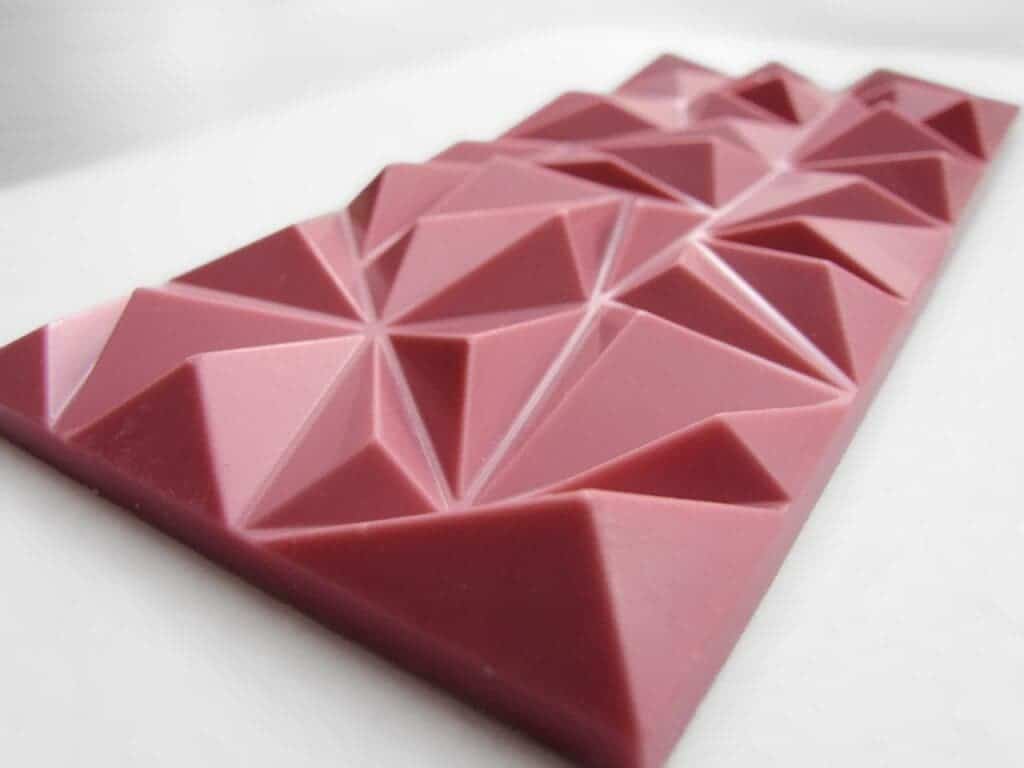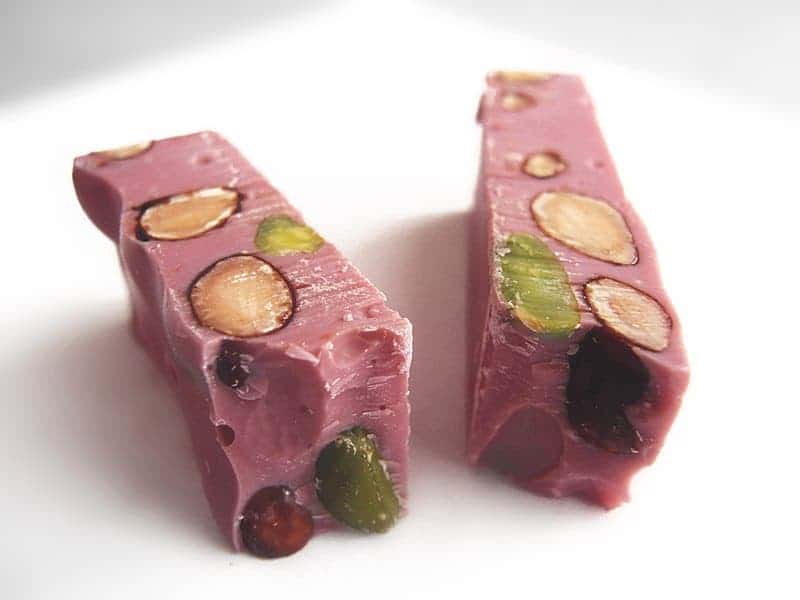If you haven’t been paying attention, you may have missed the appearance of a new type of chocolate: ruby chocolate. Developed in 2017 by a Swiss chocolatier, this variety officially became the fourth type of chocolate, after white, dark, and milk chocolate.

Chocolate fans, rejoice
Swiss chocolatier Barry Callebaut is a household name in the chocolate sphere. The company not only supplies chocolate to the likes of Nestle, Hershey, Unilever, and Mondelez, but many top restaurants and professionals use the Callebaut for its classic taste that has remained unchanged for decades — and the company still uses whole-bean roasting, instead of roasting cocoa kernels, just as it did 100 years ago. But Callebaut also likes to try out new things.
The variety has been under study for over 10 years, ever since chocolate experts at Barry Callebaut noticed that components of certain cocoa beans could produce chocolate with an unusual color and flavor. Like grapes for fine wine, these cocoa beans had to be selected and cared for under special climate conditions. According to Callebaut, these conditions can be found in Ecuador, Brazil, or the Ivory Coast.
Although the exact production method of ruby chocolate is a trade secret, some publications believe they’ve zoomed in on the source of ruby cocoa: beans from a variety called Brazil Lavados, which can have a natural pinkish color and a sour, delicate taste. The beans take a more intense color after being treated with an acid, and after they are defatted (a standard process in the chocolate industry), they revert to a truly pink color.
It’s the first new type of chocolate developed in over 80 years after white chocolate was introduced in 1936. The ruby chocolate also has a unique taste. It’s completely unlike dark or milk chocolate, and only bears a slight resemblance to white chocolate, but boasts a berry-type flavor and a slight tart aftertaste. It’s not overly sweet and carries an overall slight aroma.
“Ruby chocolate is an intense sensorial delight. A tension between berry-fruitiness and luscious smoothness,” they write in a press release. “Ruby chocolate is made from the Ruby cocoa bean; through a unique processing, Barry Callebaut unlocks the flavor and color tone naturally present in the Ruby bean. No berries or berry flavor is added. No color is added.”

Of course, developing the first new type of chocolate in almost a century can bring in a lot of money, in addition to bragging rights. So many, including ourselves, were skeptical and thinking that this could be little more than marketing. However, several studies analyzing ruby chocolate noted its particularities.
Ruby chocolate science
A study from 2019 compared ruby chocolate to its dark, white, and milk counterparts. The researchers noted that ruby chocolate does exhibit a different phenolic content than all the other types of chocolate (phenols are mildly acidic aromatic compounds), ranging somewhere between milk and white chocolate. The researchers also added that ruby chocolate has a higher content of specific compounds (such as flavan-3-ols and proanthocyanidins).
However, when the researchers subjected the chocolate to a sensory assessment, they found that ruby chocolate was the least desirable type of chocolate of the attempted ones; it even fared worse than white chocolate with added berries.
“The panel was formed of 20 trained personnel, 15 female and 5 male members, who had previous experience in the assessment of confectionery products,” the study reads.
“Semisweet and dark chocolate obtained the highest score in chocolate distinctive odour, while for the same attribute, Ruby chocolate was estimated as least preferable chocolate. White chocolate with strawberry was used because of similar sensory characteristics as Ruby chocolate, regarding taste and fruity odour, and was rated with a higher score compared to Ruby. The highest intensity of acidity was determined in Ruby chocolate, which is its main characteristic. All estimated sensory attributes were scored the best for the semisweet chocolate, while Ruby chocolate was least acceptable chocolate.”
Another study from 2021 confirmed the distinctive chemical components of ruby chocolate, analyzing its chemistry in unprecedented detail.
“The data show that a wide range of phytochemicals, present in the “conventional” dark and milk chocolates are present in ruby chocolate too. Most interesting is the finding that proanthocyanidins [a class of polyphenols found in many plants, such as cranberry, blueberry, and grape seeds] of the A-type appear to be characteristic for ruby chocolate, while B-type proanthocyanidins were found mainly in the dark chocolate,” the study read.
Researchers essentially confirmed that ruby chocolate is indeed a distinct type of chocolate.
“Ruby chocolate contained higher levels of epicatechin and procyanidin B2, compared to milk chocolate, which may be the result of a shorter, or no fermentation of the cocoa beans starting material used for the production of ruby chocolate. Moreover, the ruby chocolate was the only chocolate in which caffeic acid could be quantified,” the team noted.
However, the team made no claims regarding the quality or overall appeal of ruby chocolate. All in all, although genetically, the cocoa beans used to produce ruby chocolate are not genetically different from others used to create other types of chocolate, the way they are selected and processed leads to a product that is indeed chemically distinct.
The future of ruby chocolate

So where does this leave ruby chocolate? The product is still relatively new, but it’s been penetrating quite a few markets already. The first mass-market release was in January 2018, when it was introduced as a new flavor of Kit Kat in Japan and South Korea. Nestlé, the manufacturers of Kit Kat had an exclusive 6-month deal for the use of pink chocolate, but that has since expired and several companies in different countries have already started selling pink chocolate products. It’s not just straight chocolate, either. For instance, Magnum sells ice cream bars dipped in ruby chocolate, while Costa and Starbucks are each selling ruby chocolate-based drinks. It’s not exactly common, and its relatively low supply still limits production and distribution, but ruby chocolate seems to be catching on.
Regulators are also taking it seriously. The US Food and Drug Administration, for instance, set a standard for ruby chocolate — it must contain a minimum of 1.5% nonfat cacao solids and a minimum of 20% of cacao fat by weight. It also cannot contain flavors that mimic milk, butter, fruits, or additional coloring.
Whether or not ruby chocolate truly becomes a staple remains to be seen, but so far, the future looks promising. It will likely retain its novelty or delicacy status for some time, but it’s not unlikely for it to become as diversified as white chocolate.
However, it will likely be plagued by what many experts see as a chocolate crisis on the horizon. Cocoa beans require very specific conditions (and ruby beans even more so), and climate change is reducing their habitat more and more, basically pushing producers into a corner. If you ever needed another reason for fighting climate change, here it is: it’s coming for our chocolate.






